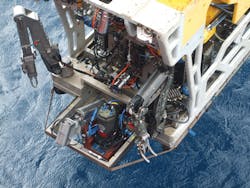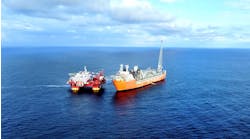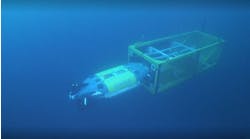Next Geosolutions has sub-contracted M² Subsea to support unexploded ordnance identification (UXO) surveys for the Nord Stream 2 gas pipeline system in the Baltic Sea.
To support the 90-day project on the Nord Stream 2, M2 Subsea has signed its first charter agreement for the multi-purpose support vessel (MSV) Go Electra, which recently successfully completed its first five-year class inspection.
The scope of work will be project managed from Aberdeen and will see the MSV deployed from Hanko in Finland, and supported by 15 company personnel who will carry out the UXO identification work using a Triton XLX 2 work class ROV and a Mohican 5 observation/inspection class ROV. The company says that the campaign will be undertaken in an area noted for munitions discoveries following the end of World War II.
Companies collaborate on underwater mapping
2G Robotics Inc. and Sonardyne International Ltd, UK. have entered into a formal collaboration agreement. The two organizations are working together on the development and promotion of a dynamic underwater laser mapping solution which is said to reduce the time needed to survey seafloor sites and offshore structures.
The new agreement centers on the integration of Sonardyne’s acoustically-aided inertial navigation system for underwater vehicles, SPRINT-Mapper, with 2G Robotics’ ULS-500 PRO dynamic underwater laser scanner. Projects conducted over the past six months have shown that combining the high resolution afforded by the 2G Robotics’ laser scanner, with an unprecedented level of practical positioning accuracy, produces a complete solution for fast and efficient dynamic laser scanning projects. These include archaeological surveys, pipeline, and free span inspections, structural integrity monitoring and one of the most demanding of all survey tasks, pipeline metrology.
Until now, the companies said in a statement, attempts at mapping from dynamic platforms have largely involved multi-beam imaging sonars being fitted to ROVs, AUVs, and manned submersibles equipped with inertial, Doppler, acoustic positioning and depth instrumentation. As a result of their mobility, large areas can be quickly surveyed but this approach typically only achieves up to 10 cm relative accuracy - effectively ruling out applications like metrology which require centimetre or better accuracy.
The new technique uses the 2G Robotics ULS-500 PRO laser scanner fitted to an underwater vehicle to capture high density point clouds of subsea assets and environments. As the vehicle moves around the site, the SPRINT-Mapper hardware, also fitted to the vehicle, simultaneously collects raw acoustic and inertial navigation data. On completion of the survey, the raw navigational data is post-processed and merged with the laser data to produce a georeferenced 3D point cloud from which centimetric level or better engineering measurements can be taken.
By adopting a dynamic platform such as an ROV navigated using SPRINT-Mapper, the high-resolution laser data is no longer constrained by a stationary deployment location - so that an entire site can now be surveyed quickly and with the flexibility to overcome adverse conditions such as visibility. As the underwater vehicle does not have to come into contact with the seabed at the survey site, it can move to scan any target of interest from a variety of perspectives.
This new partnership represents an important development for the customer seeking to employ this powerful survey technology. Through the agreement, both 2G Robotics and Sonardyne, as well as their distributors, can now offer a complete package for dynamic scanning - effectively eliminating any integration challenges faced by the end customer.
Edward Moller, Global Business Manager for Construction Survey at Sonardyne said that small bolt-holes, individual chain links, marine growth and even painted markings can all be clearly seen.
STATS completes pipeline repair
STATS Group has completed a subsea pipeline repair and isolation project in the Gulf of Thailand.
CUEL commissioned the company to address damage to the 8-in. gas condensate export pipeline which had been dragged 8 m (26 ft) out of position by a vessel anchor and needed a permanent repair.
For this program STATS deployed products that included slab valves, hot tap fittings, completion plugs, end connectors, and abandonment plugs.This allowed the repair to be effected without impacting production or diver safety.
An 8-in. bypass was installed on the seabed as a permanent repair to re-route the pipeline medium away from the damaged pipeline section, which was in around 60 m (197 ft) of water and which had an operating pressure ranging from 7-21 bar (101-304 psi). STATS’ applied its BISEP system to provide leak-tight isolation of the pressurized pipeline, deployed through a full bore hot tap penetration at the isolation location via a mechanical hot tap fitting.
The company’s previous subsea isolation, for COOEC Subsea Technology, involved repairing the Yacheng pipeline in the South China Sea following damage by a ship’s anchor. It repaired the line at an unpiggable location 280 km (174 mi) from shore and in water depths of 60 m without depressurizing and flooding the entire pipeline.





